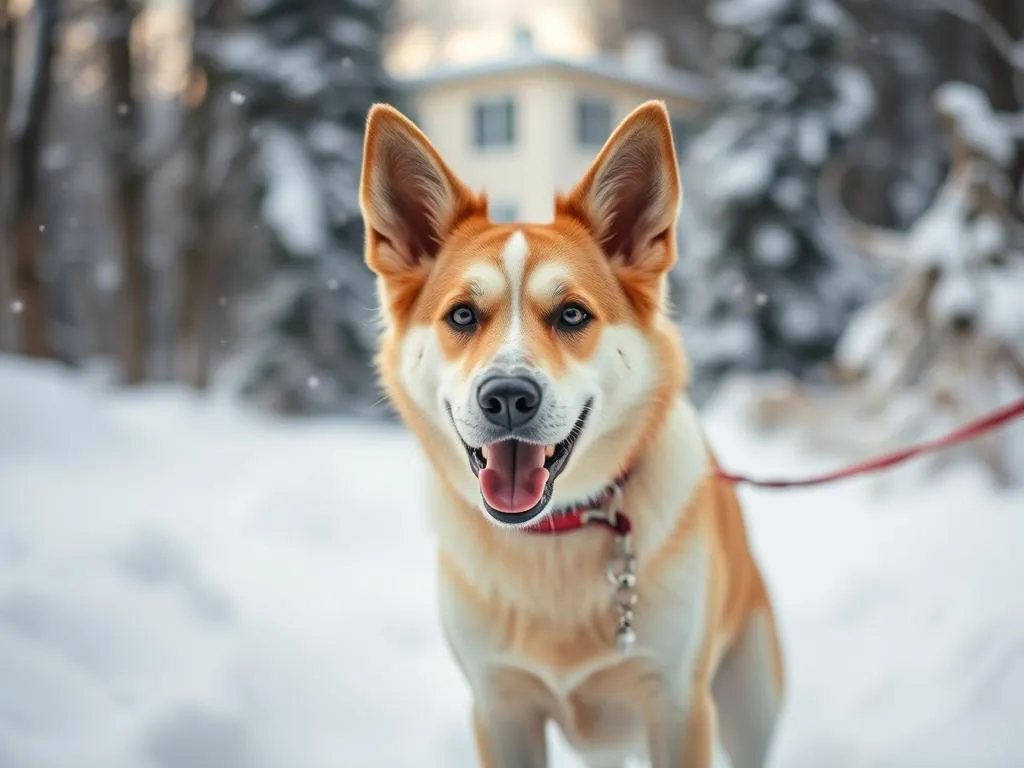
Introduction
As winter blankets the world in snow and frost, many pet owners might find themselves wondering how to keep their furry companions active and engaged during the colder months. Winter activities to do with your dog are not just about keeping them physically fit; they also promote mental stimulation and strengthen the bond between you and your pooch. Engaging in fun winter activities can be a fantastic way to enrich your dog’s life while providing them with the exercise they need to stay healthy.
In this blog post, we will explore a variety of winter activities to do with your dog, from outdoor adventures to cozy indoor games. Whether your dog loves to romp in the snow or prefers a quiet afternoon of training, there’s something for every canine companion to enjoy this winter.
Preparing for Winter Activities
Assessing Your Dog’s Health
Before embarking on any winter activities to do with your dog, it’s crucial to ensure your pet is in good health. A visit to the veterinarian is advisable to check for any underlying conditions that could be exacerbated by cold weather. Common winter-related health issues can include frostbite, hypothermia, and arthritis flare-ups.
Keep an eye out for signs of cold stress in your dog, such as shivering, lethargy, or reluctance to go outside. If you notice any of these symptoms, it’s essential to limit their exposure to extreme temperatures and consult your vet if necessary.
Choosing the Right Gear
Just as you prepare yourself for winter, your dog needs the right gear to stay warm and safe. Essential winter gear for dogs includes:
- Coats: A warm, insulated coat can help keep your dog warm during walks and playtime.
- Boots: Protect your dog’s paws from ice, snow, and salt with well-fitted dog boots.
- Reflective Gear: If you plan to take evening walks, consider reflective gear for both you and your dog to enhance visibility.
Don’t forget to layer up yourself! A warm jacket, gloves, and boots will keep you comfortable, allowing you to focus on enjoying your time outdoors with your dog.
Understanding Your Dog’s Breed and Temperament
Different breeds react to cold weather in various ways. For instance, Northern breeds like Huskies and Malamutes are generally well-equipped to handle cold temperatures, while short-haired breeds like Chihuahuas may require extra protection. Understanding your dog’s breed and temperament can help tailor your activities to their comfort levels and energy needs.
For high-energy dogs, consider more vigorous activities, while older dogs or those with lower energy levels may enjoy more relaxed outings.
Outdoor Winter Activities
Snow Play
One of the most delightful winter activities to do with your dog is playing in the snow. Dogs love the feel of fresh snow under their paws, and it can be an excellent opportunity for exercise and fun. Snow play games can include:
- Fetch: Use a brightly colored ball or toy that stands out against the snow.
- Hide and Seek: Hide behind a tree or snowbank and call your dog to find you.
- Snow Tunnels: Create tunnels for your dog to explore.
These activities not only provide physical exercise but also stimulate your dog’s mind as they navigate through the winter wonderland.
Hiking in Winter Wonderland
If you and your dog enjoy the great outdoors, consider winter hiking. Many trails are dog-friendly year-round, and hiking in winter offers a unique experience with stunning landscapes. When choosing a trail, look for:
- Accessibility: Ensure the trail is open and safe for dogs in winter.
- Terrain: Opt for well-marked trails, avoiding areas with excessive ice or deep snow.
Safety is paramount during winter hikes. Bring adequate water for both you and your dog, and keep an eye on the weather conditions.
Sledding or Skijoring
For the adventurous dog and owner, skijoring offers a thrilling way to explore winter scenery. This activity involves skiing while being pulled by your dog, combining exercise for both of you.
To get started:
- Training: Begin by teaching your dog basic commands like “go,” “stop,” and “turn.”
- Gear: Invest in a skijoring harness for your dog and a good-quality ski setup for yourself.
- Safety Precautions: Always start in a safe, open area and use a leash until your dog is comfortable with the activity.
Winter Sports
If you and your dog are both sporty, consider engaging in dog-friendly winter sports such as canicross or snowshoeing.
- Canicross: This sport combines running and dog walking. Your dog is harnessed and attached to you, allowing for a fun run through snowy trails.
- Snowshoeing: This is a great way to enjoy the winter landscape while getting exercise. Most dogs love bounding through the snow, making it a fun outing.
Training your dog for these activities can be enjoyable and rewarding. Start with short distances and gradually increase as your dog builds stamina.
Indoor Winter Activities
Interactive Games
When the weather outside is too harsh, indoor play can be just as engaging. Here are some ideas for mentally stimulating games:
- Puzzle Toys: Invest in toys that require your dog to problem-solve for treats.
- Hide Treats: Hide treats around the house and let your dog use their nose to find them.
- Tug-of-War: A classic game that can be played safely indoors.
Creating a fun and engaging environment indoors can help combat winter blues for both you and your dog.
Obedience Training
Winter is also a great time to continue your dog’s training. Maintaining an active training schedule can keep your dog mentally sharp. Fun exercises to try include:
- Learning New Tricks: Teach your dog fun tricks like roll over, play dead, or spin.
- Agility Training: Set up a mini-agility course using furniture and household items.
Regular training sessions not only reinforce good behavior but also strengthen your bond with your furry friend.
DIY Dog Spa Day
A DIY dog spa day is a perfect way to pamper your pup while staying warm indoors. Here’s how to create a relaxing experience:
- Grooming: Brush your dog’s coat to remove any loose fur and reduce shedding.
- Bathing: Use a dog-friendly shampoo and warm water to give your dog a relaxing bath.
- Massage: Spend time massaging your dog to help them relax and strengthen your connection.
Not only will your dog feel good, but grooming during winter can help prevent matting and skin issues due to dry air.
Socializing with Other Dogs
Finding Local Dog Parks
Socialization is vital for your dog’s well-being, even in winter. Finding local dog parks that are open during the colder months can provide opportunities for playdates and interaction with other dogs.
Tips for locating dog parks include:
- Online Research: Check social media groups or local forums for recommendations.
- Visit During Off-Peak Hours: This can help you find parks that are less crowded and more enjoyable for your dog.
Winter playdates can help maintain your dog’s social skills while providing them with much-needed exercise.
Joining Dog Clubs or Classes
Consider joining dog clubs or classes that offer activities throughout the winter. These structured environments can provide excellent opportunities for socialization and learning.
Benefits of participating in these groups include:
- Structured Activities: Engaging in planned activities can help keep your dog physically and mentally active.
- Socialization: Meeting other dogs and their owners can lead to lasting friendships for both you and your pet.
Safety Tips for Winter Activities
Recognizing Signs of Cold Stress
While many dogs enjoy winter activities, it’s essential to recognize when they may be getting too cold. Signs of cold stress include:
- Shivering: A clear indication that your dog is cold and needs to warm up.
- Lethargy: If your dog seems unusually tired or reluctant to move, it might be time to head inside.
- Excessive Barking: This can indicate discomfort or stress.
Always err on the side of caution and bring your dog indoors if you notice any warning signs.
Hydration and Nutrition
Even in winter, your dog needs to stay hydrated. Make sure to provide fresh water after outdoor activities. Additionally, consider nutritional adjustments, such as:
- Higher Caloric Needs: Active dogs may need more calories during winter months to maintain energy levels.
- Warm Meals: Offering warm food can be more appealing and comforting for your dog in colder weather.
Protecting Paws
Cold weather can be tough on your dog’s paws. To care for their feet, consider the following:
- Paw Balm: Use a protective balm on your dog’s paws before outdoor activities to prevent cracking.
- Boots: Invest in a good pair of dog boots to protect against ice and salt.
- Post-Activity Care: After walks, check your dog’s paws for any signs of injury or irritation.
Taking these precautions can help keep your dog’s feet healthy and comfortable throughout the winter season.
Conclusion
Engaging in winter activities to do with your dog is essential for maintaining their physical health, mental stimulation, and overall happiness. From outdoor adventures in the snow to cozy indoor games, there are endless opportunities for you and your dog to bond and create lasting memories this winter.
As you explore new activities, remember to keep your dog’s safety and comfort in mind. The joys of winter can be fully enjoyed with your furry friend by your side, so don’t hesitate to make the most of the season. Whether you’re hiking through a snow-covered trail or enjoying a warm spa day at home, the time spent together is what truly counts.









